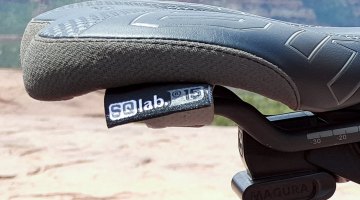Advertisement
Rotor Bike Components has been busy developing a new hydraulic shifting system it is calling Uno, as well as a dual-sided power meter, built around one of the Spanish company's iconic cranks, called the 2INpower. Today we're sharing our (quite lengthy) initial impressions on the innovative Uno drivetrain and brakes, with our typical technical analysis from the perspective of a cyclocross and gravel rider. Stay tuned for more on the 2INpower system.
Under the Uno Hood
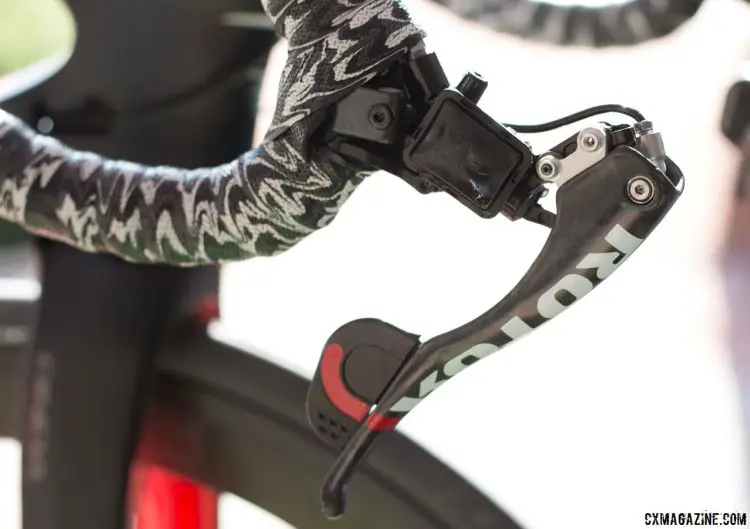
Rotor’s Uno hydraulic shifters, underneath the cover. There’s no tiny springs or cogs to jam should you endo in the sand pit. © Cyclocross Magazine
Open the hood on a Rotor Uno lever, and you’ll quickly see the appeal and promise of the hydraulic system. There’s no tiny gears, springs or cables to get contaminated up here. Most obvious is the hydraulic brake master cylinder from Magura, which uses mineral oil, and then the port for the Rotor shift fluid, which is basically 30% glycol antifreeze.
The brake fluid is routed through a standard-looking hydraulic brake hose, while the shift fluid is contained in a 5mm hose, similar in diameter to a coffee stirring straw. At the handlebar, on our Pinarello Dogma Disk road test bike, it’s contained and protected in housing, routes internally through the frame, but at the rear derailleur, the thin fluid housing is visible, and makes the final loop to the derailleur, much like a cable would.

A view of the carbon bar clamp and Magura master cyclinder on Rotor’s Uno hydraulic shifting component group. © Cyclocross Magazine
Uno shift levers work much like SRAM’s DoubleTap, with a short throw on the right for upshifts, and a longer throw for downshifts. On the left, just like DoubleTap, it’s reversed, with a longer throw required to upshift into the large chainring.
The rear derailleur forces you to rethink your typical adjustments. There’s no cable tension thumbscrew of course, and so set up and making adjustments has a learning curve, but is quite simple and in theory requires just adjusting one limit screw. Which one? There’s only one, at the low side (biggest cog, easiest gear), to prevent you from shifting into your wheel wrecking the derailleur, and on our test bike the carbon spokes on the $7,000+ USD Lightweight Wheels. The indexing is already set and assumes you have a 11-speed cassette. Rotor doesn’t make a cassette yet, so we were running Shimano, but in terms of spacing, the Rotor Uno system is brand agnostic, as the cassette spacing between the various brands of drivetrains is very close.
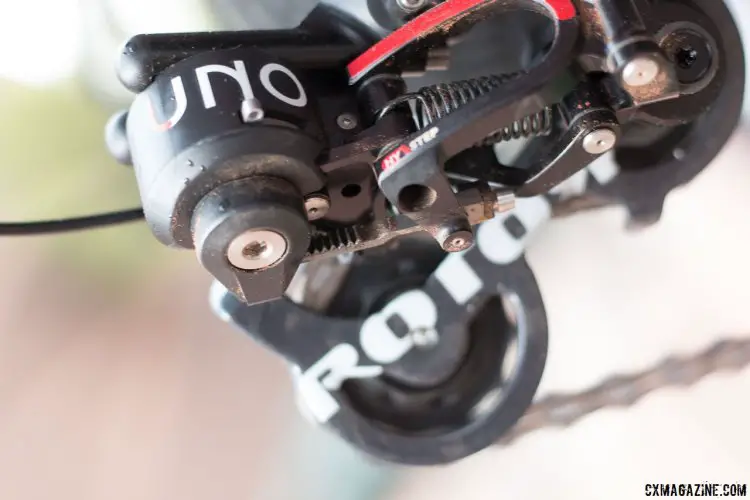
The Uno hydraulic rear derailleur maintains the indexing, not the shifter. Theoretically, you could upgrade it to 12 speeds or more in the future, if the industry goes that way and Rotor supports a retrofit. We do worry that the indexing here could get contaminated. © Cyclocross Magazine
Look closely, and you will see two more adjustment screws on the Rotor Uno rear derailleur. One is to customize your multishift setting. Want each push of the lever to downshift (easier) just one gear? Turn off multishift. Want it to downshift two, three of four gears with a long push, similar to DoubleTap? You can set the Uno derailleur to any of these three options. Given the undulating terrain of cyclocross, we’re guessing racers will want to leave it on the four-shift setting. Of course, that doesn’t mean you have to shift four gears at once. A little dexterity and finger muscle memory will have you downshifting one, two, three or four gears at once.
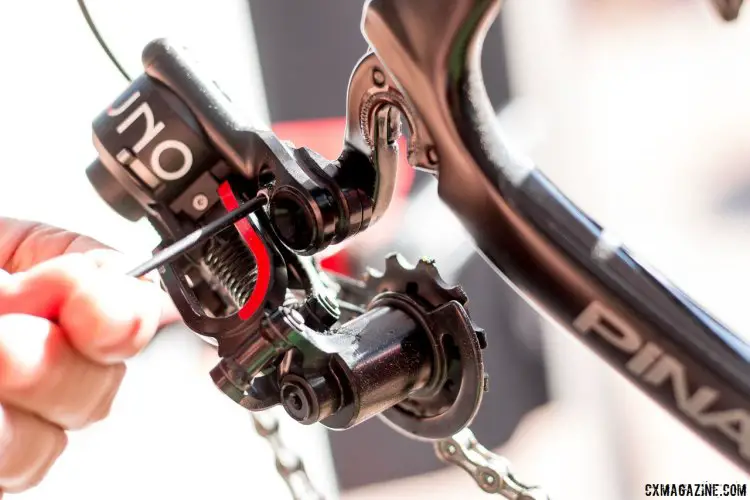
Rotor’s Uno rear derailleur uses small hey keys to adjust the one limit screw, multishift ability, and chain stretch compensation. © Cyclocross Magazine
The second adjustment screw is for chain stretch. This tweaks derailleur travel a bit to accommodate a looser, more flexible chain. With just one ride under my belt, I didn’t play with this micro adjustment.
The front derailleur is very similar to the rear derailleur in operation, minus the multishift and chain stretch adjustments. There’s one limit screw, and you can obviously adjust the height and angle via the mount. The system offers four positions with two positions per chainring—trim options which should be familiar to long-time Shimano STI users. A light tap on the left Uno lever moves the front derailleur into the trim position to avoid chain rub, while a harder/longer lever throw shifts chainrings.
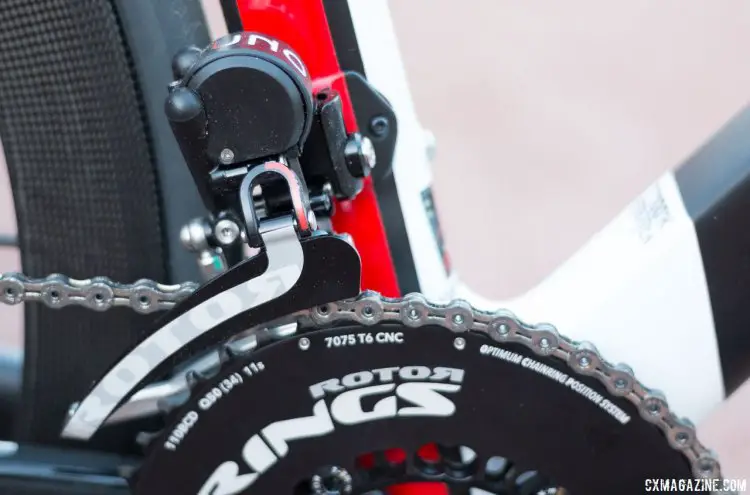
Rotor’s Uno hydraulic shifting front derailleur shifts through the company’s oval Q-rings and offers trim settings in each ring. © Cyclocross Magazine
Both Rotor and Magura will offer their own bleed kits for the system, as fluids and hose diameters are different. Rotor will recommend riders to bleed their shift system once a year, but says lever feel will likely dictate the exact duration.
Wheel removal and installation are interesting and arguably easier. There’s a high-normal spring that can be used to move the derailleur closest to smallest cog. You can also flip a switch and you can push the derailleur into the gear of your choice. This should also make traveling with the bike in your car or a case a little easier.
Stopping the Wheel, Not Reinventing It

Our Dogma Disk (with a k) test bike with Rotor’s Uno hydraulic shifting component group and Lightweight’s new disc wheels. © Cyclocross Magazine
Rotor didn’t feel there was a need to reinvent the wheel when it came to braking, and partnered with Magura for engineering help with its own hydraulics but also for the German company’s already well-established braking options. The Rotor Uno system will offer disc and rim brake configurations, and our test bike naturally had the disc brake option.
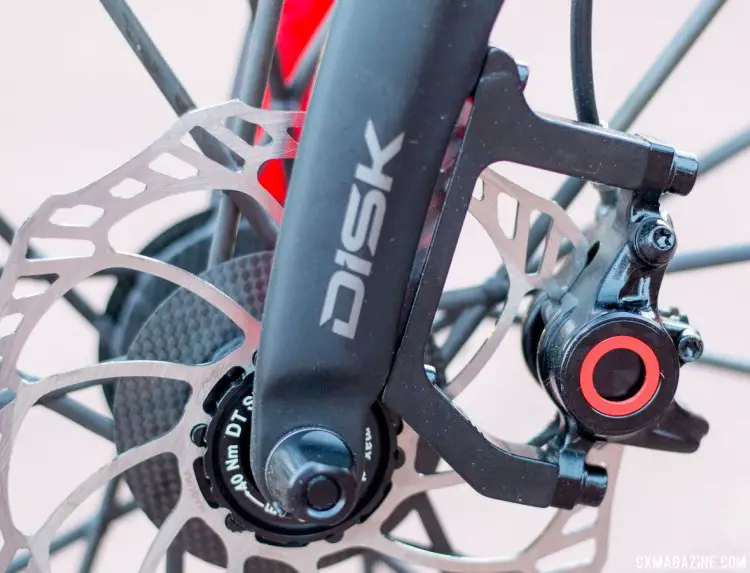
Rotor’s Uno group features Magura’s MT8 mineral oil-based hydraulic disc brakes. © Cyclocross Magazine
The brake, based on Magura’s popular lightweight MT8 mountain bike brake, features dual piston braking and only comes with 160mm rotors. With adaptors, customers can run other sizes of course, but Magura and Rotor feel that the 160mm rotors offer the best combination of modulation, power and cooling.
Enough details. How does it shift? Brake? Read our candid impressions on the next page.


























